BUSS 3103: International Business - M&S Textiles in Bangladesh Report
VerifiedAdded on 2022/09/18
|7
|1691
|25
Report
AI Summary
This report analyzes the strategic decision of M&S Textiles to establish a manufacturing plant in Bangladesh. It begins with an introduction to Marks & Spencer and the challenges it faces in the Australian market due to competition and supply chain inefficiencies. The report then delves into the textile manufacturing environment in Bangladesh, highlighting its advantages such as low labor costs, abundant resources, and favorable government policies. It examines the trade and government policies that support international investment in Bangladesh, including liberal trade rules and incentives. The report explores the potential benefits for M&S, including reduced manufacturing costs, increased market share, and access to the UK and US markets. The report also includes the executive summary, introduction & background, Thailand's textile industry, business environment (culture, ethics & corruption, legal & trade), market entry strategies, and conclusions with references.
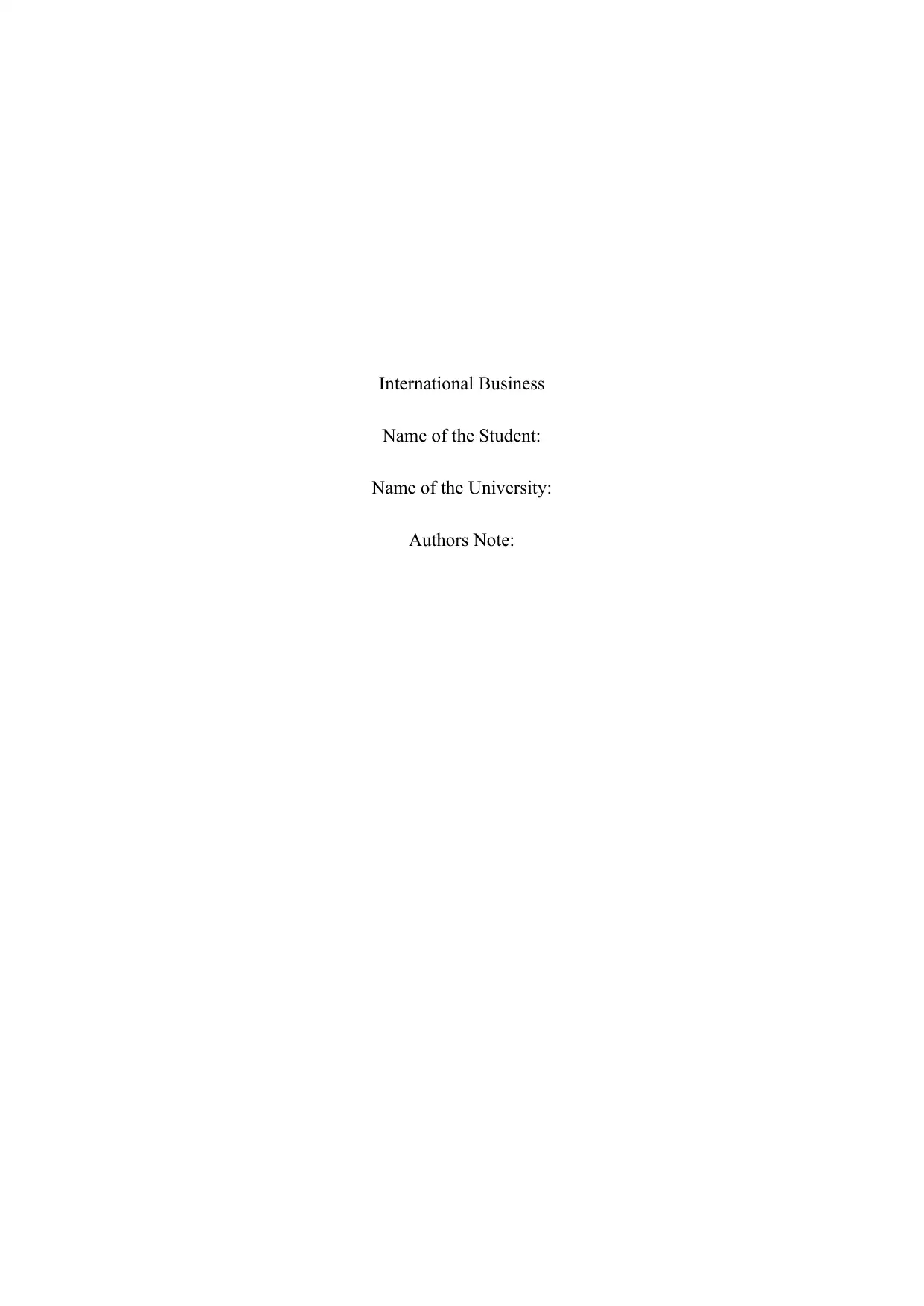
International Business
Name of the Student:
Name of the University:
Authors Note:
Name of the Student:
Name of the University:
Authors Note:
Paraphrase This Document
Need a fresh take? Get an instant paraphrase of this document with our AI Paraphraser
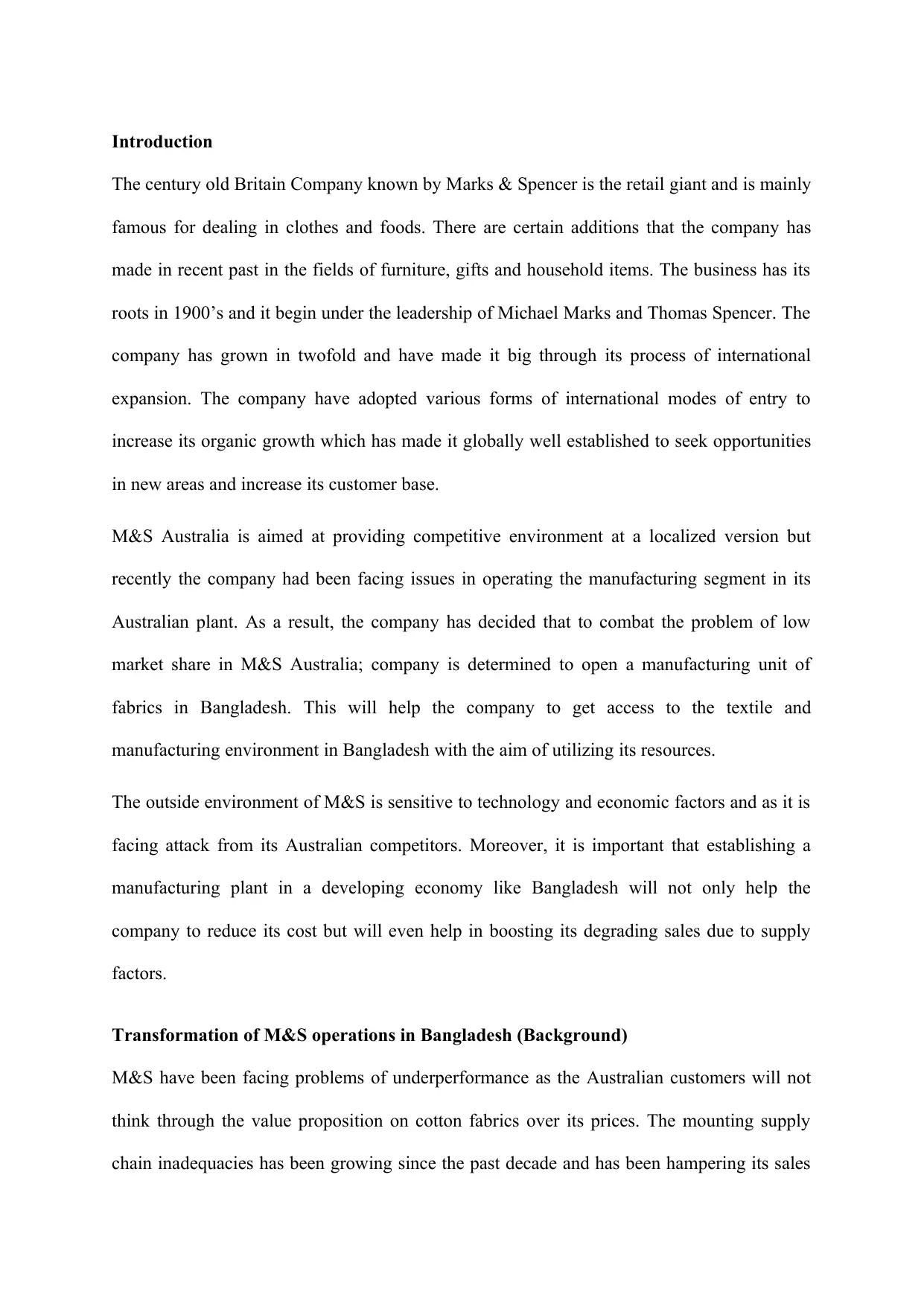
Introduction
The century old Britain Company known by Marks & Spencer is the retail giant and is mainly
famous for dealing in clothes and foods. There are certain additions that the company has
made in recent past in the fields of furniture, gifts and household items. The business has its
roots in 1900’s and it begin under the leadership of Michael Marks and Thomas Spencer. The
company has grown in twofold and have made it big through its process of international
expansion. The company have adopted various forms of international modes of entry to
increase its organic growth which has made it globally well established to seek opportunities
in new areas and increase its customer base.
M&S Australia is aimed at providing competitive environment at a localized version but
recently the company had been facing issues in operating the manufacturing segment in its
Australian plant. As a result, the company has decided that to combat the problem of low
market share in M&S Australia; company is determined to open a manufacturing unit of
fabrics in Bangladesh. This will help the company to get access to the textile and
manufacturing environment in Bangladesh with the aim of utilizing its resources.
The outside environment of M&S is sensitive to technology and economic factors and as it is
facing attack from its Australian competitors. Moreover, it is important that establishing a
manufacturing plant in a developing economy like Bangladesh will not only help the
company to reduce its cost but will even help in boosting its degrading sales due to supply
factors.
Transformation of M&S operations in Bangladesh (Background)
M&S have been facing problems of underperformance as the Australian customers will not
think through the value proposition on cotton fabrics over its prices. The mounting supply
chain inadequacies has been growing since the past decade and has been hampering its sales
The century old Britain Company known by Marks & Spencer is the retail giant and is mainly
famous for dealing in clothes and foods. There are certain additions that the company has
made in recent past in the fields of furniture, gifts and household items. The business has its
roots in 1900’s and it begin under the leadership of Michael Marks and Thomas Spencer. The
company has grown in twofold and have made it big through its process of international
expansion. The company have adopted various forms of international modes of entry to
increase its organic growth which has made it globally well established to seek opportunities
in new areas and increase its customer base.
M&S Australia is aimed at providing competitive environment at a localized version but
recently the company had been facing issues in operating the manufacturing segment in its
Australian plant. As a result, the company has decided that to combat the problem of low
market share in M&S Australia; company is determined to open a manufacturing unit of
fabrics in Bangladesh. This will help the company to get access to the textile and
manufacturing environment in Bangladesh with the aim of utilizing its resources.
The outside environment of M&S is sensitive to technology and economic factors and as it is
facing attack from its Australian competitors. Moreover, it is important that establishing a
manufacturing plant in a developing economy like Bangladesh will not only help the
company to reduce its cost but will even help in boosting its degrading sales due to supply
factors.
Transformation of M&S operations in Bangladesh (Background)
M&S have been facing problems of underperformance as the Australian customers will not
think through the value proposition on cotton fabrics over its prices. The mounting supply
chain inadequacies has been growing since the past decade and has been hampering its sales
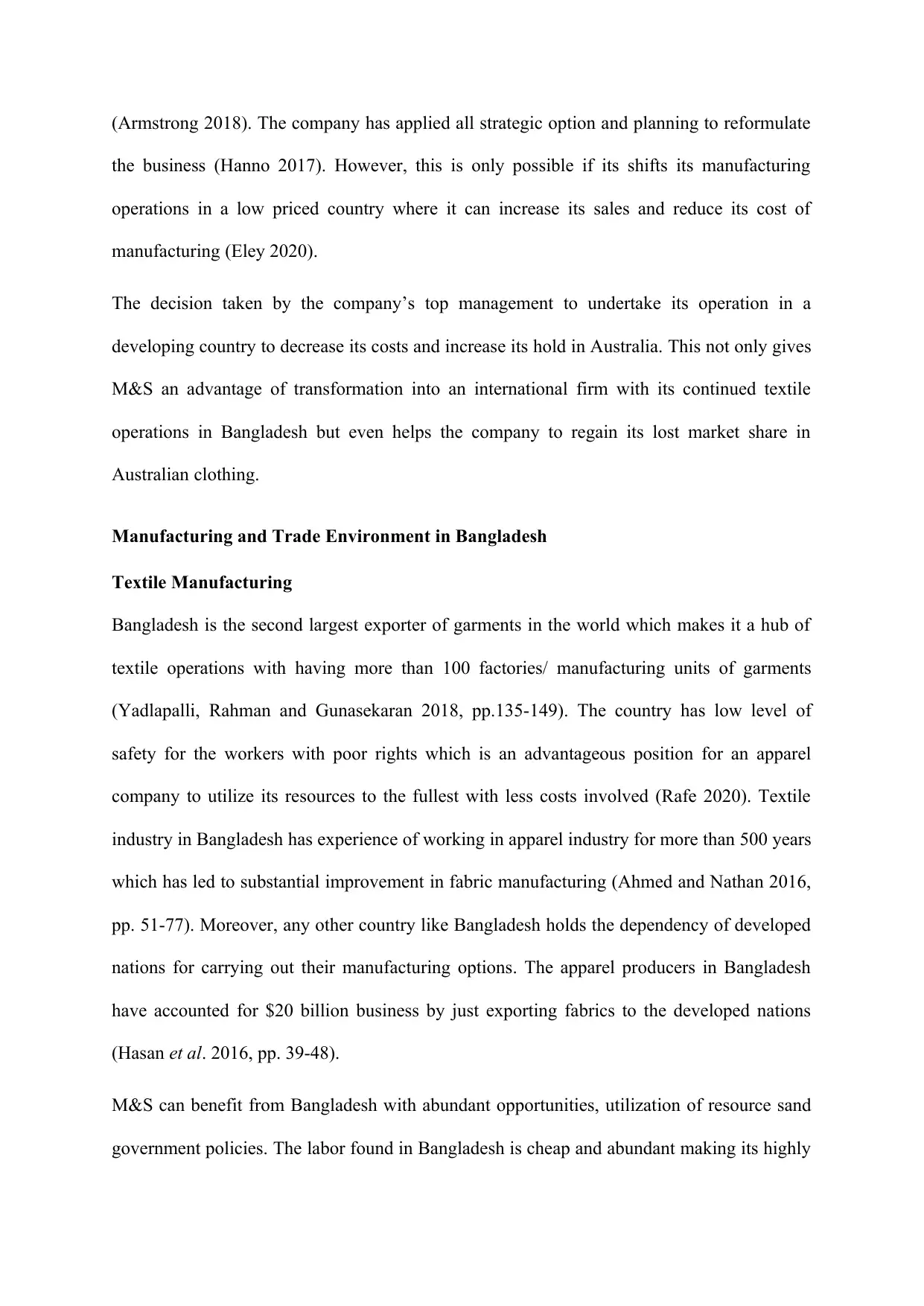
(Armstrong 2018). The company has applied all strategic option and planning to reformulate
the business (Hanno 2017). However, this is only possible if its shifts its manufacturing
operations in a low priced country where it can increase its sales and reduce its cost of
manufacturing (Eley 2020).
The decision taken by the company’s top management to undertake its operation in a
developing country to decrease its costs and increase its hold in Australia. This not only gives
M&S an advantage of transformation into an international firm with its continued textile
operations in Bangladesh but even helps the company to regain its lost market share in
Australian clothing.
Manufacturing and Trade Environment in Bangladesh
Textile Manufacturing
Bangladesh is the second largest exporter of garments in the world which makes it a hub of
textile operations with having more than 100 factories/ manufacturing units of garments
(Yadlapalli, Rahman and Gunasekaran 2018, pp.135-149). The country has low level of
safety for the workers with poor rights which is an advantageous position for an apparel
company to utilize its resources to the fullest with less costs involved (Rafe 2020). Textile
industry in Bangladesh has experience of working in apparel industry for more than 500 years
which has led to substantial improvement in fabric manufacturing (Ahmed and Nathan 2016,
pp. 51-77). Moreover, any other country like Bangladesh holds the dependency of developed
nations for carrying out their manufacturing options. The apparel producers in Bangladesh
have accounted for $20 billion business by just exporting fabrics to the developed nations
(Hasan et al. 2016, pp. 39-48).
M&S can benefit from Bangladesh with abundant opportunities, utilization of resource sand
government policies. The labor found in Bangladesh is cheap and abundant making its highly
the business (Hanno 2017). However, this is only possible if its shifts its manufacturing
operations in a low priced country where it can increase its sales and reduce its cost of
manufacturing (Eley 2020).
The decision taken by the company’s top management to undertake its operation in a
developing country to decrease its costs and increase its hold in Australia. This not only gives
M&S an advantage of transformation into an international firm with its continued textile
operations in Bangladesh but even helps the company to regain its lost market share in
Australian clothing.
Manufacturing and Trade Environment in Bangladesh
Textile Manufacturing
Bangladesh is the second largest exporter of garments in the world which makes it a hub of
textile operations with having more than 100 factories/ manufacturing units of garments
(Yadlapalli, Rahman and Gunasekaran 2018, pp.135-149). The country has low level of
safety for the workers with poor rights which is an advantageous position for an apparel
company to utilize its resources to the fullest with less costs involved (Rafe 2020). Textile
industry in Bangladesh has experience of working in apparel industry for more than 500 years
which has led to substantial improvement in fabric manufacturing (Ahmed and Nathan 2016,
pp. 51-77). Moreover, any other country like Bangladesh holds the dependency of developed
nations for carrying out their manufacturing options. The apparel producers in Bangladesh
have accounted for $20 billion business by just exporting fabrics to the developed nations
(Hasan et al. 2016, pp. 39-48).
M&S can benefit from Bangladesh with abundant opportunities, utilization of resource sand
government policies. The labor found in Bangladesh is cheap and abundant making its highly
⊘ This is a preview!⊘
Do you want full access?
Subscribe today to unlock all pages.

Trusted by 1+ million students worldwide
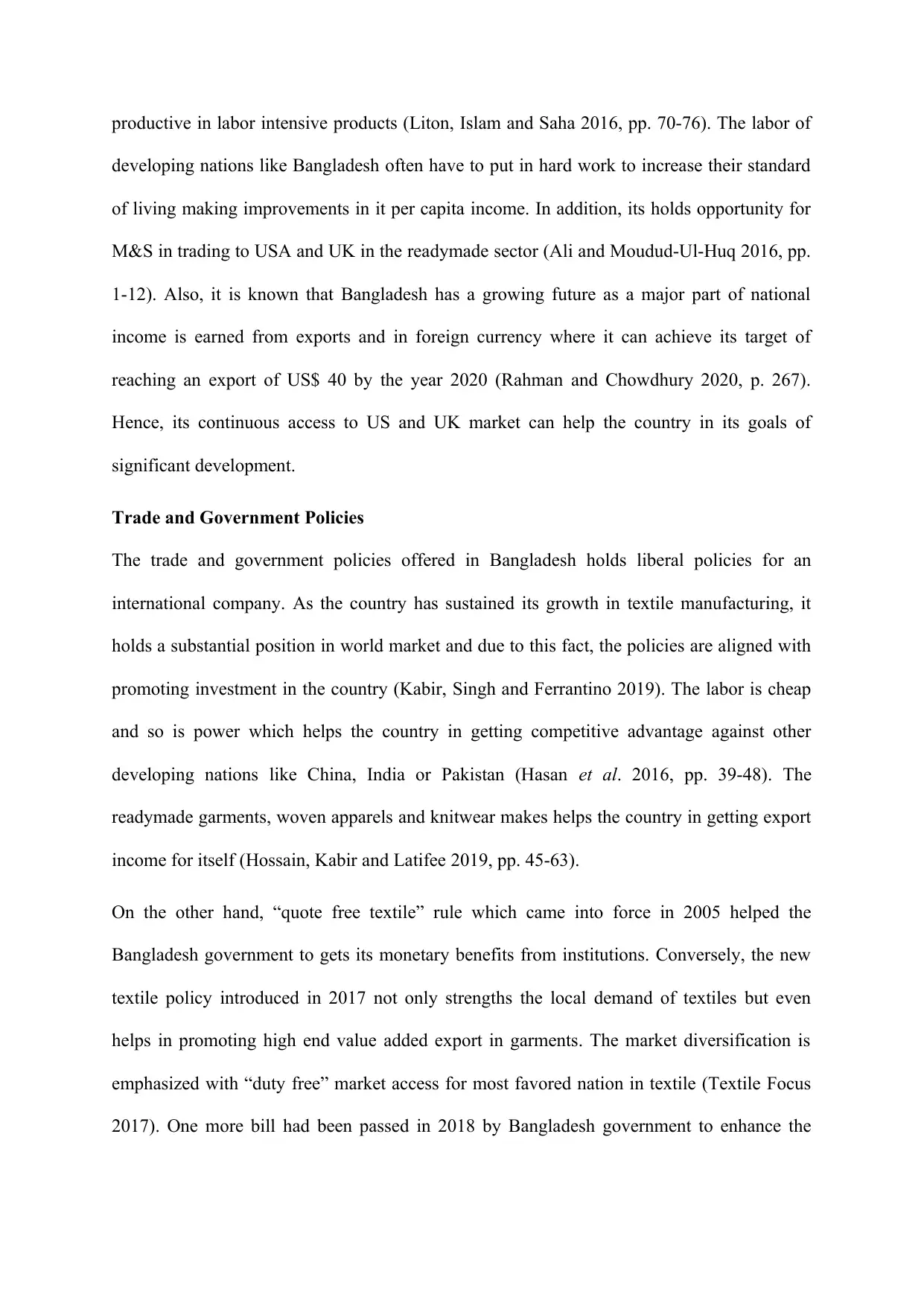
productive in labor intensive products (Liton, Islam and Saha 2016, pp. 70-76). The labor of
developing nations like Bangladesh often have to put in hard work to increase their standard
of living making improvements in it per capita income. In addition, its holds opportunity for
M&S in trading to USA and UK in the readymade sector (Ali and Moudud-Ul-Huq 2016, pp.
1-12). Also, it is known that Bangladesh has a growing future as a major part of national
income is earned from exports and in foreign currency where it can achieve its target of
reaching an export of US$ 40 by the year 2020 (Rahman and Chowdhury 2020, p. 267).
Hence, its continuous access to US and UK market can help the country in its goals of
significant development.
Trade and Government Policies
The trade and government policies offered in Bangladesh holds liberal policies for an
international company. As the country has sustained its growth in textile manufacturing, it
holds a substantial position in world market and due to this fact, the policies are aligned with
promoting investment in the country (Kabir, Singh and Ferrantino 2019). The labor is cheap
and so is power which helps the country in getting competitive advantage against other
developing nations like China, India or Pakistan (Hasan et al. 2016, pp. 39-48). The
readymade garments, woven apparels and knitwear makes helps the country in getting export
income for itself (Hossain, Kabir and Latifee 2019, pp. 45-63).
On the other hand, “quote free textile” rule which came into force in 2005 helped the
Bangladesh government to gets its monetary benefits from institutions. Conversely, the new
textile policy introduced in 2017 not only strengths the local demand of textiles but even
helps in promoting high end value added export in garments. The market diversification is
emphasized with “duty free” market access for most favored nation in textile (Textile Focus
2017). One more bill had been passed in 2018 by Bangladesh government to enhance the
developing nations like Bangladesh often have to put in hard work to increase their standard
of living making improvements in it per capita income. In addition, its holds opportunity for
M&S in trading to USA and UK in the readymade sector (Ali and Moudud-Ul-Huq 2016, pp.
1-12). Also, it is known that Bangladesh has a growing future as a major part of national
income is earned from exports and in foreign currency where it can achieve its target of
reaching an export of US$ 40 by the year 2020 (Rahman and Chowdhury 2020, p. 267).
Hence, its continuous access to US and UK market can help the country in its goals of
significant development.
Trade and Government Policies
The trade and government policies offered in Bangladesh holds liberal policies for an
international company. As the country has sustained its growth in textile manufacturing, it
holds a substantial position in world market and due to this fact, the policies are aligned with
promoting investment in the country (Kabir, Singh and Ferrantino 2019). The labor is cheap
and so is power which helps the country in getting competitive advantage against other
developing nations like China, India or Pakistan (Hasan et al. 2016, pp. 39-48). The
readymade garments, woven apparels and knitwear makes helps the country in getting export
income for itself (Hossain, Kabir and Latifee 2019, pp. 45-63).
On the other hand, “quote free textile” rule which came into force in 2005 helped the
Bangladesh government to gets its monetary benefits from institutions. Conversely, the new
textile policy introduced in 2017 not only strengths the local demand of textiles but even
helps in promoting high end value added export in garments. The market diversification is
emphasized with “duty free” market access for most favored nation in textile (Textile Focus
2017). One more bill had been passed in 2018 by Bangladesh government to enhance the
Paraphrase This Document
Need a fresh take? Get an instant paraphrase of this document with our AI Paraphraser
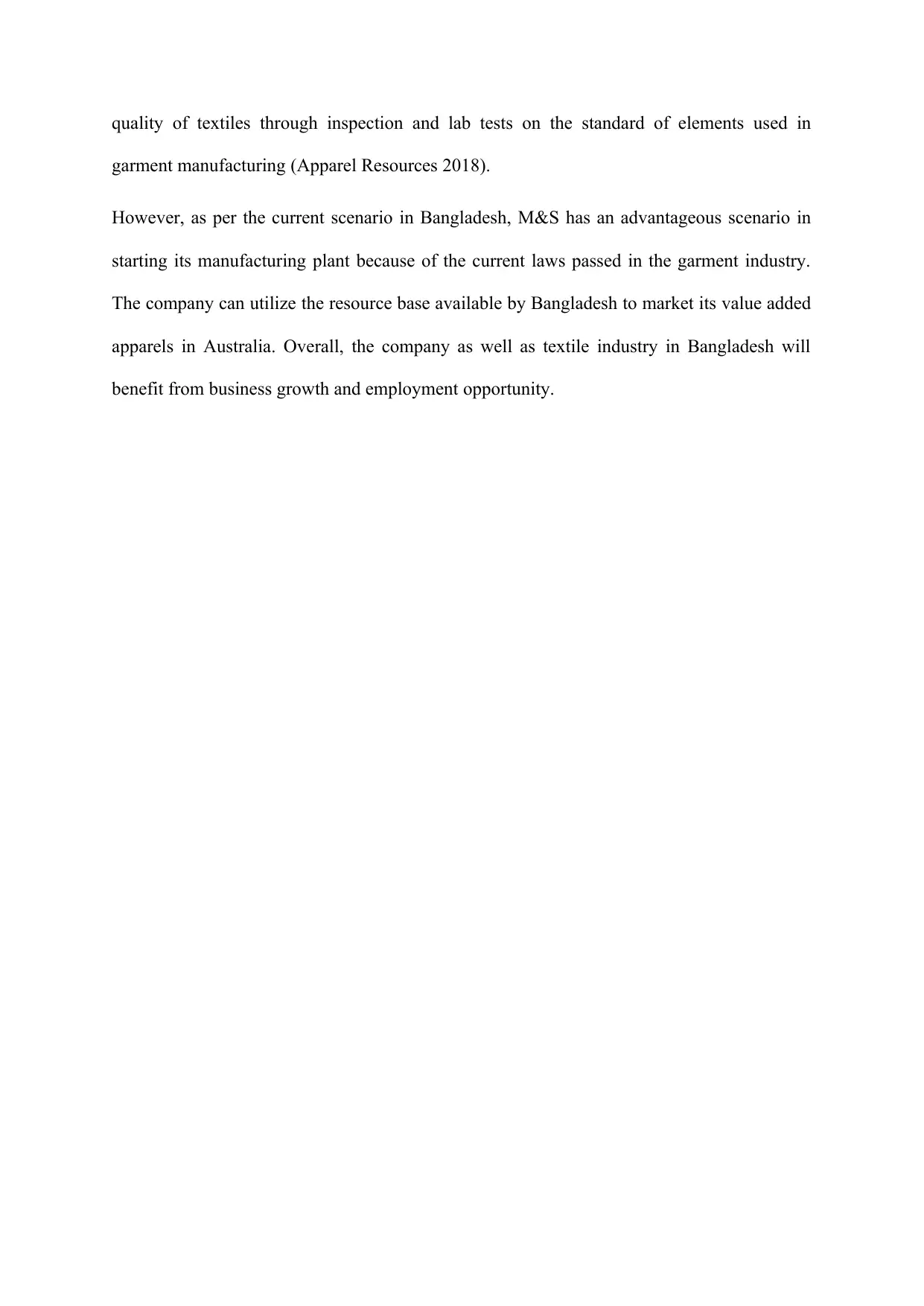
quality of textiles through inspection and lab tests on the standard of elements used in
garment manufacturing (Apparel Resources 2018).
However, as per the current scenario in Bangladesh, M&S has an advantageous scenario in
starting its manufacturing plant because of the current laws passed in the garment industry.
The company can utilize the resource base available by Bangladesh to market its value added
apparels in Australia. Overall, the company as well as textile industry in Bangladesh will
benefit from business growth and employment opportunity.
garment manufacturing (Apparel Resources 2018).
However, as per the current scenario in Bangladesh, M&S has an advantageous scenario in
starting its manufacturing plant because of the current laws passed in the garment industry.
The company can utilize the resource base available by Bangladesh to market its value added
apparels in Australia. Overall, the company as well as textile industry in Bangladesh will
benefit from business growth and employment opportunity.
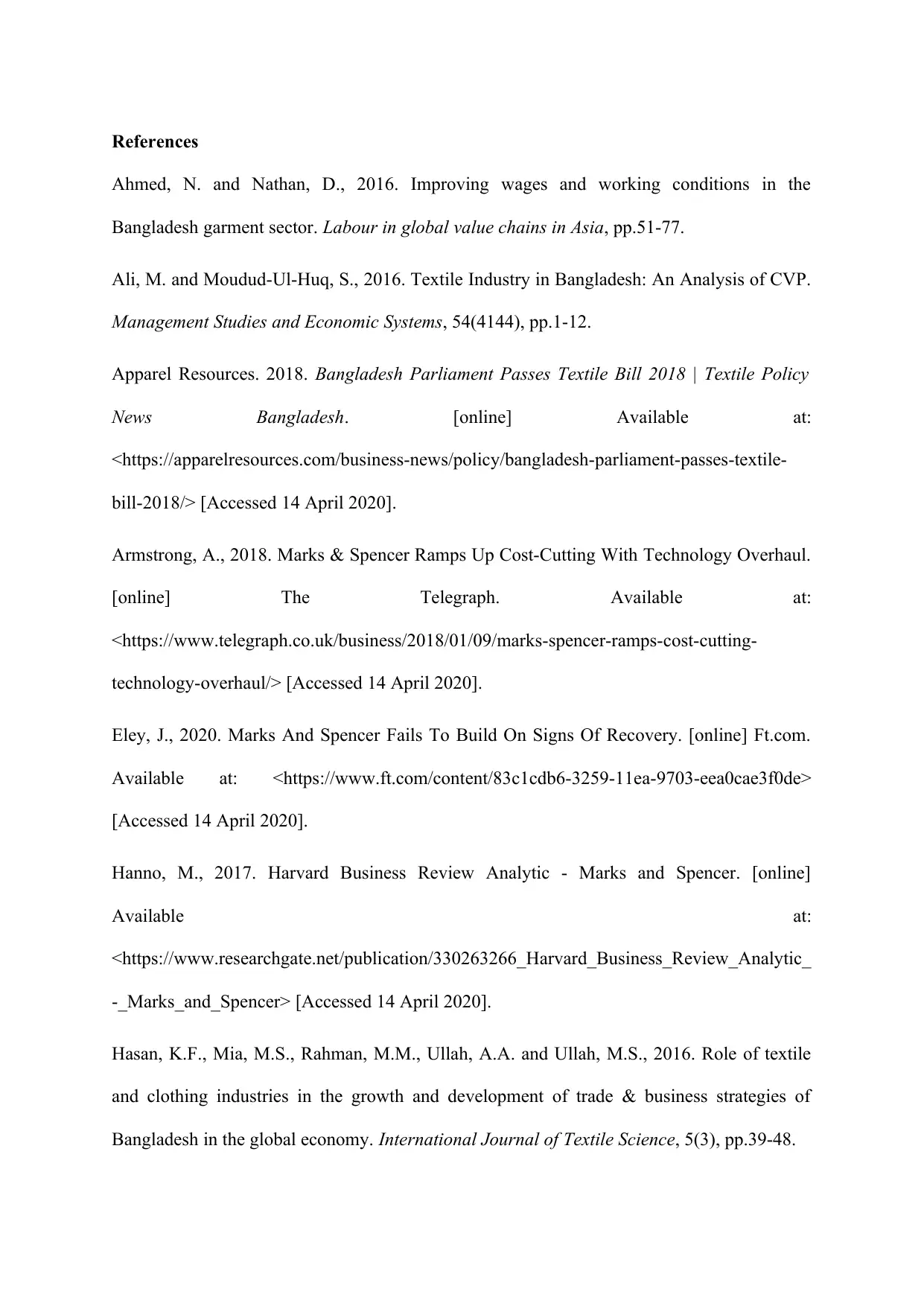
References
Ahmed, N. and Nathan, D., 2016. Improving wages and working conditions in the
Bangladesh garment sector. Labour in global value chains in Asia, pp.51-77.
Ali, M. and Moudud-Ul-Huq, S., 2016. Textile Industry in Bangladesh: An Analysis of CVP.
Management Studies and Economic Systems, 54(4144), pp.1-12.
Apparel Resources. 2018. Bangladesh Parliament Passes Textile Bill 2018 | Textile Policy
News Bangladesh. [online] Available at:
<https://apparelresources.com/business-news/policy/bangladesh-parliament-passes-textile-
bill-2018/> [Accessed 14 April 2020].
Armstrong, A., 2018. Marks & Spencer Ramps Up Cost-Cutting With Technology Overhaul.
[online] The Telegraph. Available at:
<https://www.telegraph.co.uk/business/2018/01/09/marks-spencer-ramps-cost-cutting-
technology-overhaul/> [Accessed 14 April 2020].
Eley, J., 2020. Marks And Spencer Fails To Build On Signs Of Recovery. [online] Ft.com.
Available at: <https://www.ft.com/content/83c1cdb6-3259-11ea-9703-eea0cae3f0de>
[Accessed 14 April 2020].
Hanno, M., 2017. Harvard Business Review Analytic - Marks and Spencer. [online]
Available at:
<https://www.researchgate.net/publication/330263266_Harvard_Business_Review_Analytic_
-_Marks_and_Spencer> [Accessed 14 April 2020].
Hasan, K.F., Mia, M.S., Rahman, M.M., Ullah, A.A. and Ullah, M.S., 2016. Role of textile
and clothing industries in the growth and development of trade & business strategies of
Bangladesh in the global economy. International Journal of Textile Science, 5(3), pp.39-48.
Ahmed, N. and Nathan, D., 2016. Improving wages and working conditions in the
Bangladesh garment sector. Labour in global value chains in Asia, pp.51-77.
Ali, M. and Moudud-Ul-Huq, S., 2016. Textile Industry in Bangladesh: An Analysis of CVP.
Management Studies and Economic Systems, 54(4144), pp.1-12.
Apparel Resources. 2018. Bangladesh Parliament Passes Textile Bill 2018 | Textile Policy
News Bangladesh. [online] Available at:
<https://apparelresources.com/business-news/policy/bangladesh-parliament-passes-textile-
bill-2018/> [Accessed 14 April 2020].
Armstrong, A., 2018. Marks & Spencer Ramps Up Cost-Cutting With Technology Overhaul.
[online] The Telegraph. Available at:
<https://www.telegraph.co.uk/business/2018/01/09/marks-spencer-ramps-cost-cutting-
technology-overhaul/> [Accessed 14 April 2020].
Eley, J., 2020. Marks And Spencer Fails To Build On Signs Of Recovery. [online] Ft.com.
Available at: <https://www.ft.com/content/83c1cdb6-3259-11ea-9703-eea0cae3f0de>
[Accessed 14 April 2020].
Hanno, M., 2017. Harvard Business Review Analytic - Marks and Spencer. [online]
Available at:
<https://www.researchgate.net/publication/330263266_Harvard_Business_Review_Analytic_
-_Marks_and_Spencer> [Accessed 14 April 2020].
Hasan, K.F., Mia, M.S., Rahman, M.M., Ullah, A.A. and Ullah, M.S., 2016. Role of textile
and clothing industries in the growth and development of trade & business strategies of
Bangladesh in the global economy. International Journal of Textile Science, 5(3), pp.39-48.
⊘ This is a preview!⊘
Do you want full access?
Subscribe today to unlock all pages.

Trusted by 1+ million students worldwide
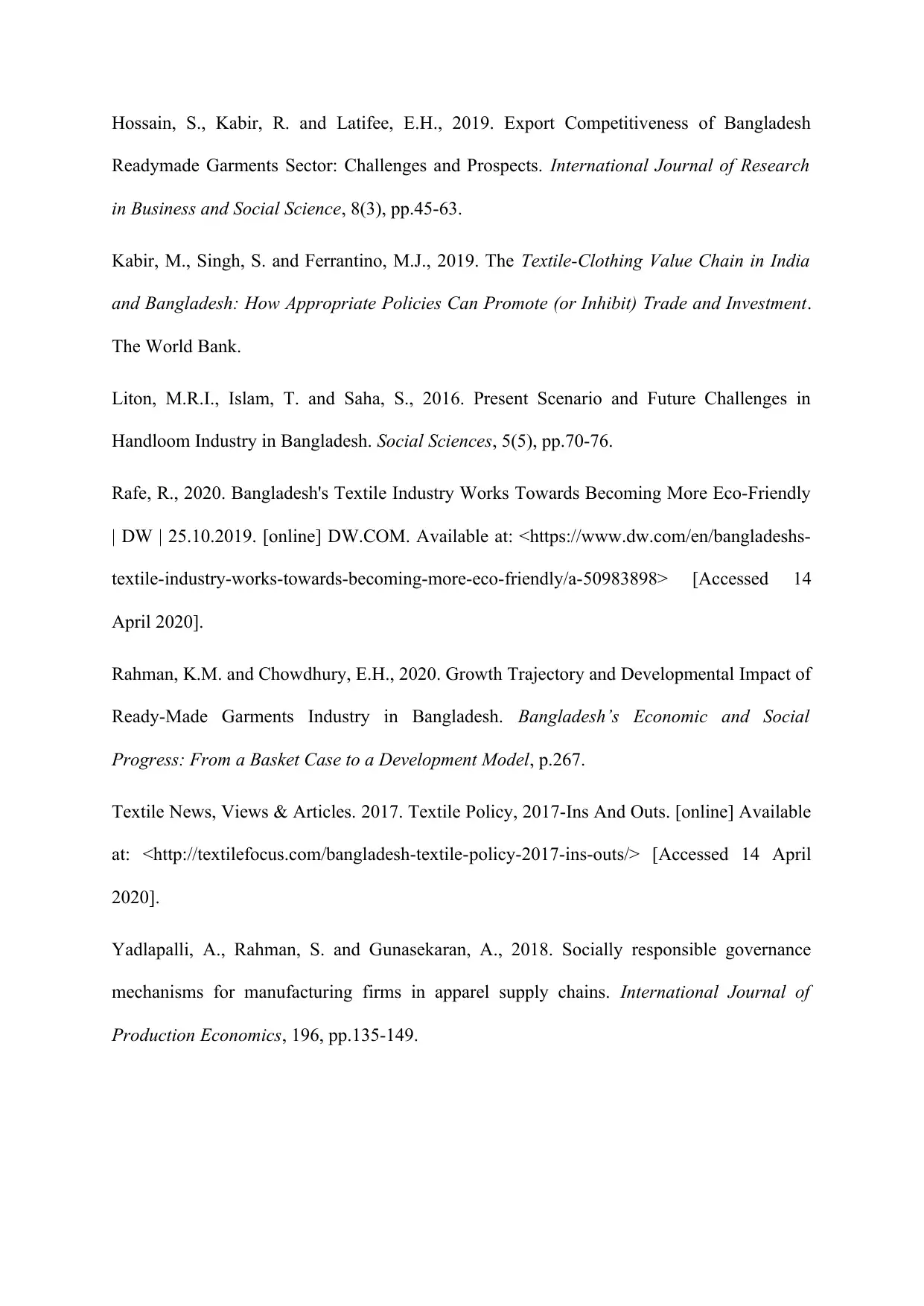
Hossain, S., Kabir, R. and Latifee, E.H., 2019. Export Competitiveness of Bangladesh
Readymade Garments Sector: Challenges and Prospects. International Journal of Research
in Business and Social Science, 8(3), pp.45-63.
Kabir, M., Singh, S. and Ferrantino, M.J., 2019. The Textile-Clothing Value Chain in India
and Bangladesh: How Appropriate Policies Can Promote (or Inhibit) Trade and Investment.
The World Bank.
Liton, M.R.I., Islam, T. and Saha, S., 2016. Present Scenario and Future Challenges in
Handloom Industry in Bangladesh. Social Sciences, 5(5), pp.70-76.
Rafe, R., 2020. Bangladesh's Textile Industry Works Towards Becoming More Eco-Friendly
| DW | 25.10.2019. [online] DW.COM. Available at: <https://www.dw.com/en/bangladeshs-
textile-industry-works-towards-becoming-more-eco-friendly/a-50983898> [Accessed 14
April 2020].
Rahman, K.M. and Chowdhury, E.H., 2020. Growth Trajectory and Developmental Impact of
Ready-Made Garments Industry in Bangladesh. Bangladesh’s Economic and Social
Progress: From a Basket Case to a Development Model, p.267.
Textile News, Views & Articles. 2017. Textile Policy, 2017-Ins And Outs. [online] Available
at: <http://textilefocus.com/bangladesh-textile-policy-2017-ins-outs/> [Accessed 14 April
2020].
Yadlapalli, A., Rahman, S. and Gunasekaran, A., 2018. Socially responsible governance
mechanisms for manufacturing firms in apparel supply chains. International Journal of
Production Economics, 196, pp.135-149.
Readymade Garments Sector: Challenges and Prospects. International Journal of Research
in Business and Social Science, 8(3), pp.45-63.
Kabir, M., Singh, S. and Ferrantino, M.J., 2019. The Textile-Clothing Value Chain in India
and Bangladesh: How Appropriate Policies Can Promote (or Inhibit) Trade and Investment.
The World Bank.
Liton, M.R.I., Islam, T. and Saha, S., 2016. Present Scenario and Future Challenges in
Handloom Industry in Bangladesh. Social Sciences, 5(5), pp.70-76.
Rafe, R., 2020. Bangladesh's Textile Industry Works Towards Becoming More Eco-Friendly
| DW | 25.10.2019. [online] DW.COM. Available at: <https://www.dw.com/en/bangladeshs-
textile-industry-works-towards-becoming-more-eco-friendly/a-50983898> [Accessed 14
April 2020].
Rahman, K.M. and Chowdhury, E.H., 2020. Growth Trajectory and Developmental Impact of
Ready-Made Garments Industry in Bangladesh. Bangladesh’s Economic and Social
Progress: From a Basket Case to a Development Model, p.267.
Textile News, Views & Articles. 2017. Textile Policy, 2017-Ins And Outs. [online] Available
at: <http://textilefocus.com/bangladesh-textile-policy-2017-ins-outs/> [Accessed 14 April
2020].
Yadlapalli, A., Rahman, S. and Gunasekaran, A., 2018. Socially responsible governance
mechanisms for manufacturing firms in apparel supply chains. International Journal of
Production Economics, 196, pp.135-149.
1 out of 7
Related Documents
Your All-in-One AI-Powered Toolkit for Academic Success.
+13062052269
info@desklib.com
Available 24*7 on WhatsApp / Email
![[object Object]](/_next/static/media/star-bottom.7253800d.svg)
Unlock your academic potential
Copyright © 2020–2025 A2Z Services. All Rights Reserved. Developed and managed by ZUCOL.





